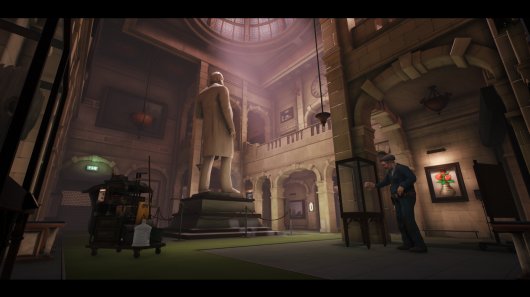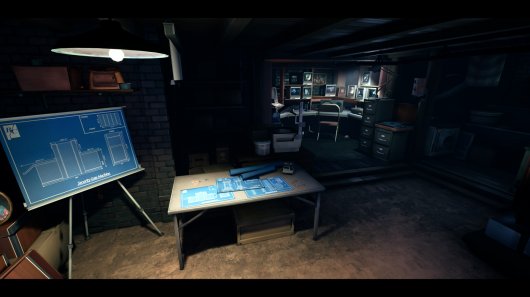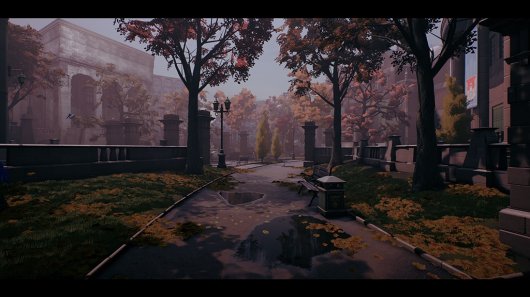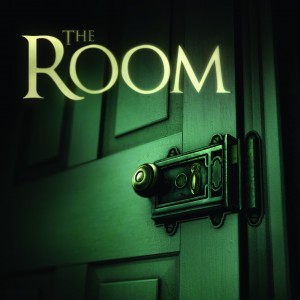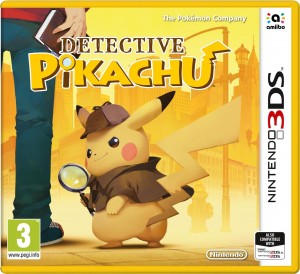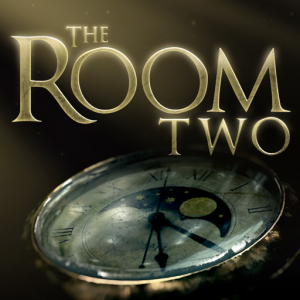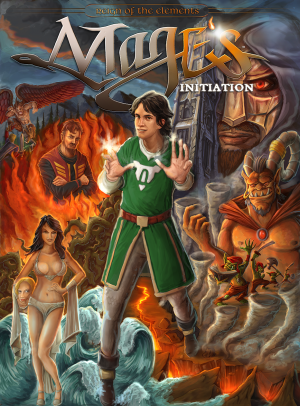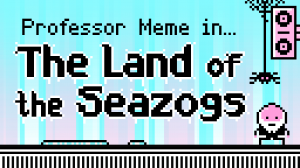Review for The Occupation
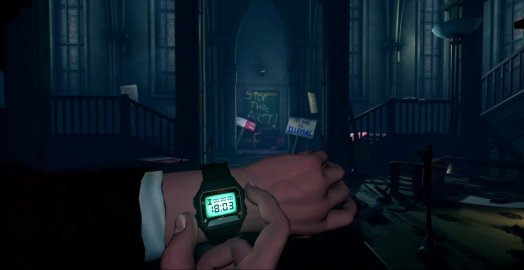
I’m crouching underneath a desk, staring at a lady’s knees, hoping she won’t notice me. She’s been sitting at the table for a few minutes now, unaware of my contorted presence, which is really eating up the time I need for my investigation. It may look right now like I’m some kind of pervert, but if I can get out from under the desk with my stolen evidence (and dignity) intact, I’ll have one hell of a story to write up – that is, if The Occupation’s finicky controls let me open the door properly first.
At its best, The Occupation places you in these kinds of tense, flinch-and-you’ll-get-caught scenarios seen in the best spy thrillers. For the most part you play investigative journalist Harvey Miller, out to seek the truth following a deadly terrorist attack in 1980s England that triggers a controversial bill – the “Union Act” – which threatens to control the populace and erode civil liberties. But you’re no Sam Fisher or Solid Snake; you don’t have guns or fancy gadgets at your disposal to incapacitate your foes. All you have are two interviews scheduled with the bosses of the secretive data-collecting corporation where the Act sprang from – and with those interviews a little bit of time to snoop around the buildings, gathering as much evidence as you can find to implicate your interviewees.
So off you toddle in first-person round the offices of Bowman Carson, trying to avoid the two main security guards Dan and Steve. When they tell you at reception that your interview with one of the bosses starts in an hour, they really mean it: The Occupation is a fixed-time game, meaning that as time goes by in real life so too do the minutes pass in these parts of the game. You can check the time at any point by bringing up your trusty wristwatch – if you’re late at the end for the interview, you won’t have as much time to ask your questions and therefore have less time to reveal the nefarious goings-on.
You’ll have one or two leads given to you by your contact to fish out at the start of each timed hour (you get 60 minutes to snoop before the second interview as well), such as printing off an important email or getting into a certain restricted area. The rest you discover by reading notes, cracking safes and decoding computers. And as we’re in the 1980s, there are no hi-tech tools to help you with your industrial espionage – if you want to copy something from a computer, you better find a floppy disc to do so, and then a fax machine to send it off to your colleague back at base.
The first hour spent crawling around, eavesdropping on conversations and flicking blinds shut to disguise your nefarious deeds is mostly a blast. Developer White Paper Games capture that feeling of being an everyday person thrust into a Hollywood movie situation with aplomb. There are multiple ways to get into most rooms, which challenges you to be creative, be it through hidden vents, open windows, picked-up key cards or alarm codes, or even following behind security guards. Finding it too difficult to sneak past a guard who’s standing right next to a room you need to get into? Why not set off the alarm in another room so he goes to tend to that one instead!
Every second counts: if you get caught by Tweedledee and Tweedledum (sorry, Dan and Steve), then you’ll be escorted back to reception and lose valuable time needed to collect clues to question and hopefully expose the corporation heads later on in your interview. Cleverly, other actions eat up time too (it takes a whole two minutes for a safe to unlock once you’ve input the codes!), forcing you to make quick decisions in prioritising certain leads and disregarding others to get things done. You will find yourself having to suspend your disbelief a little bit – why on earth would any company with lots to hide let an investigative journalist wander freely round any part of its building alone, even the unrestricted parts?! But let the very, very laidback security attitudes of Beavis and Butthead (ahem) slide and there’s a tense, exciting hour of gameplay to be had.
If only it had been kept to an hour. Whilst the first main segment of The Occupation is flawed by its tricky interface and controls, the AI is merciful enough and the gameplay fresh enough for the issues to be largely forgiven. Shuffle on to the second building for Miller’s investigative tour de force, however, and things get a lot more irritating. Suddenly ol’ Pinky and Perky can spot you through solid walls (and yes that’s Dan and Steve again patrolling an entirely new building – I hope they’re on fat paychecks with the kind of mileage they must have to cover every day on their shifts). There’s no map to pick up so you’re often bumbling around trying to get a feel for where you need to go, across several entire floors. Your dossier holds all codes, key clues and leads you pick up along the way, but clicking through folders in real time takes ages, and becomes especially frantic when you’re alerted to a guard in your vicinity and just need to find somewhere to hide.
Even worse are the clunky controls, especially annoying when you need to do fancier footwork to avoid being spotted later in the game. Climbing up boxes or crawling through vents can take several attempts with a keyboard and mouse, and opening doors often feels counterintuitive, as depending on what side you’re on they’ll often open towards you rather than away from you – meaning you have to step back and try again. For a game that places a lot of value on player speed and precision, having such awkward mechanics and unwieldy systems detracts quite heavily from any enjoyment gained from playing at being stealthy.
The game only saves after each chapter is completed, probably an attempt by the developers to make every action count and not allow you to get to know your environment too well by saving all the time. This is a bold move, but it means that you’re either going to have to live with every mistake you make due to ham-fisted controls and suffer the consequences in the storyline later, or restart the whole sequence all over again. Thankfully a recent patch seems to have cleared up some of the more game-breaking bugs (losing a key game item forever if it’s accidentally swapped with another) that the launch version suffered from, which would have made the save system even more frustrating.
After you’ve done your snooping it’s time for the actual interviews. Once everybody is sitting comfortably, you scroll through a list of questions (some of which will only appear if you’ve found enough information or clues to ask them) and present evidence to back them up. If you spent the whole hour faffing around and weren’t able to follow through with any leads, you’ll miss out on unveiling key plot points and finding out what’s really been going on behind closed doors – although the game does a good job of allowing you to find this out later through new evidence you can uncover, so that you don’t feel too punished for any earlier mistakes made.
There are a few shorter non-timed sections in between The Occupation’s main investigative bread and butter, which feel like they’re mainly there to flesh out the plot and, quite frankly, stretch out the game length at times. Most of them consist of walking between buildings, although one has you playing through a flashback of the night after the terrorist attack as a former employee of the shady Bowman Carson, picking through the debris of the destroyed building after the attack, trying to find answers. Currently there’s no chapter selection in the game, meaning if you want to revisit the actual spying and sneaking bits, you’re going to have to play through the whole game again. The developers have said they are considering implementing a chapter system in the future, which would be a welcome move for anyone wanting to perfect the fixed-time sections in particular.
Although meant to be relatively realistic, the 3D graphics have a Dishonored-like slightly cartoony feel, while examinable objects provide a pleasant sense of weight and heft to them when you pick them up. The game mainly has you exploring offices and occasionally balancing on handily placed ledges outside windows, so locations do begin to feel a bit samey, apart from brief strolls along a canal and through a leafy park lined with rows of terraced houses. The Occupation does a great job in these brief trips outside of offering a glimpse into an area rarely visited in games – 1980s North West England – and it would have been great to experience more of this, at least through flashbacks if not the present day.
Whilst Mr Miller remains uncharacteristically mute (for a journalist), actors voice his various contacts in helping gather evidence for your report, as well as their shady corporate counterparts in cut scenes and in-game conversation. Dialogue, particularly from your enigmatic informant of the shady dealings inside the company, can feel a little hammy at times, to the point of detracting from the game’s worthy political agenda. The in-game audio as you creep and crawl around fares a bit better. You’ll hear radios (with an actual DJ introducing tracks in between) blasting out catchy pop hits – original tracks recorded for the game – and you can collect vinyl LPs to play at the various record players you come across. It’s a welcome break from the sometimes comically dread-inducing Jaws-like drone that plays on a loop whenever a guard enters your vicinity and forces you to hide. Hearing it for the first time does spark a sense of mild peril, but when you discover that the best solution isn’t to carefully inch your way around the room but to leg it in plain sight around a corner until they just decide to give up and carry on with their business, any supposedly tense music quickly becomes nothing more than irksome.
This sadly sums up much of The Occupation: supposedly full of intrigue and mystery, but often feeling a little farcical in its implementation. The narrative throws up so many themes it wants you to reflect on – immigration control, individuality, civil rights, government oppression and data security to name but a few – but when you’ve only got a short span of time to chunter through endless notes and emails, it’s hard to take in every code word, name and plot twist and make sense of it all. The ending feels like it wants to build to an emotional, heartbreaking choice for the player, but after such a whirlwind of information throughout the short 4-5 hours of play time, I felt more relieved that the game was over than contemplative. Kept as a tight, one hour real-time run of code-breaking, safe-cracking and vent-crawling, The Occupation would have felt slight but strangely more purposeful, even with the clunky control issues. Instead, by expanding the scope of the story and the abilities of your opposition, the end result is a rushed narrative and over-zealous AI, for which no amount of panicked knee-watching can fully compensate.




